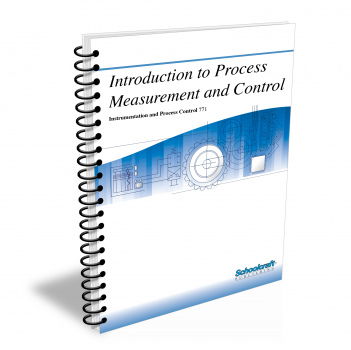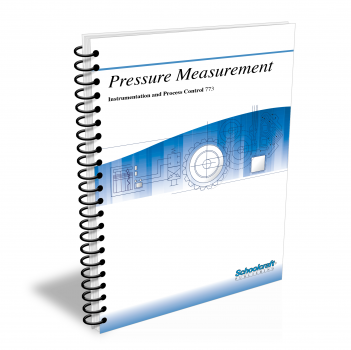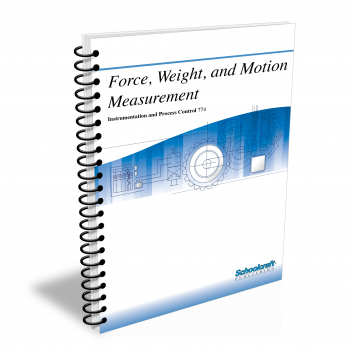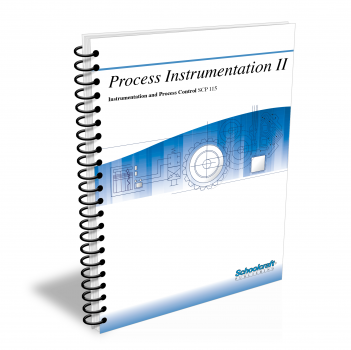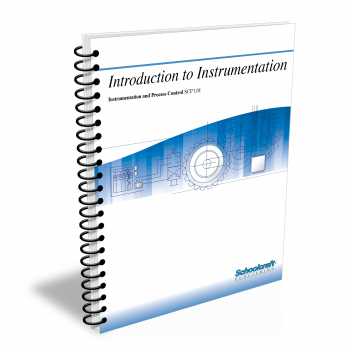Process Instrumentation I
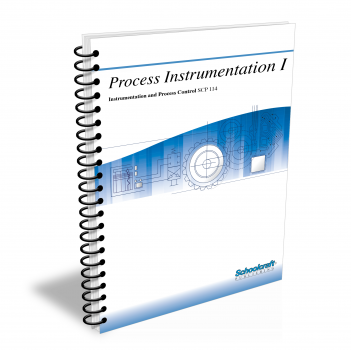
Course Number: 8114
Developed, in part, for college programs associated with the Gulf Coast Process Technology Alliance, these Process Instrumentation textbooks focus on the study of the instruments and instrument systems used in chemical processing, pulp and paper, oil refineries, food processing, and related industries. This textbook takes an applied workplace approach covering everything from a basic introduction to process control to measurements and control valves.
Does your curriculum require additional topics not included in this textbook? Build a customized version of the Process Instrumentation I textbook below.
Recommended Contact Hours – 47
Preview a Chapter
Available Supporting Material
- Table of Contents
- Exam Copies
- Suggested Titles
Table of Contents
Chapter 1: The Nature of Process Control
Topics: Process variables; On-off control; Measuring data; Controlling variables, Error and feedback; Open- and closed-loop control
Learning Objectives:
- Define setpoint and error.
- Explain how measurement and control are related in industrial processes.
- Describe the four essential functions of an automatic control system.
- Discuss the functions of the CRT and PLC in control systems.
- Identify variables in industrial processes.
- Explain the importance of feedback in a closed-loop control system.
Chapter 2: Elements of Process Control
Topics: Analog and digital control signals; ASCII; Measuring pressure, level, and flow rate; Digital pulse control; System terminology; Controller action
Learning Objectives:
- Discuss the differences between modern automatic control systems and older ones.
- Identify the standard signals used in process control.
- Define the terms commonly used in control terminology.
- Explain the differences between open-loop control and closed-loop control.
- Describe on-off, proportional, integral, derivative, and PID controller action.
Chapter 3: Process Control Signals
Topics: Linear and nonlinear transducers; Signal operating values; Error; Controller output; Pneumatic and electrical signal transmission; Control loops
Learning Objectives:
- Discuss standard signals and linearity and explain how to calculate the value of a variable from an instrument's span and range.
- Describe five common sources of error in signal measurement.
- Discuss the basic principles governing pneumatic signal transmission and explain how a flapper-nozzle device works.
- Describe the function of the controller in a control loop.
- Discuss the basic principles governing electrical signal transmission, including Ohm's law, and list standard current and voltage signals.
- Explain the function of I/P devices in a typical control system and discuss the use of digital signals and optical signals.
Chapter 4: Process Measurement Fundamentals
Topics: The purpose of measurement; Kinds of signals; Measurement requirements; Kinds of displays; Remote vs local display; Errors in measurement systems; Calibration; Noise; Response time; Measurement system deterioration; Observation errors; Transmitters; Proportionality
Learning Objectives:
- Explain why measurement is necessary and discuss conditions that affect the degree of accuracy required.
- Compare the advantages of linear and nonlinear displays.
- Compare analog and digital devices and explain how each is applied to measurement.
- Name five sources of measurement error.
- Discuss proportionality and explain how it applies to transmitters.
Chapter 5: Principles of Transducer Operation
Topics: Outputs; Mechanical, electrical, and pneumatic elements and response; Resistance, voltage, and frequency devices; Combining elements
Learning Objectives:
- Discuss the need for linearity in a process.
- List examples of mechanical and electrical transducer elements.
- Compare pneumatic response and electrical/electronic response in transducers.
- Describe the operation of the bourdon tube, bellows, and diaphragm.
- Name examples of resistance, voltage response, frequency response, and electromechanical devices and explain how they work.
- Discuss the use of the Hall-effect transducer and the differential transducer.
Chapter 6: Basic Process Measurement Systems
Topics: Interaction of system elements; Transmitters; Electrical vs. pneumatic output; Converters; Signal conditioning; Indicators and recorders
Learning Objectives:
- Discuss the basic elements of measuring systems and explain how they interact.
- Describe how a physical quantity is translated into another quantity.
- Discuss the use of transmitters to relay information from one location to another and explain the transfer function.
- Describe the operation of at least five kinds of converters.
- Compare analog and digital indicators and recorders.
Chapter 7: Temperature Measurement Principles and Indicators
Topics: Temperature and temperature scales; Heat; Change of state; Measuring instruments; Color change and melting point indicators
Learning Objectives:
- Define thermal energy and explain the relationships among thermal energy, heat, and temperature in a substance.
- Correlate changes in temperature with changes in a substance's physical state.
- Compare four temperature scales, and convert temperature readings from one scale to another.
- Explain how primary and secondary temperature calibration standards are used.
- Describe various temperature-measuring devices and contrast thermometers and pyrometers.
Chapter 8: Bimetallic and Fluid-Filled Temperature Instruments
Topics: Bimetallic, liquid-in-glass, and filled-system thermometers; Liquid- and gas-filled systems; Vapor-pressure systems; Capillary and bourdon tubes; Temperature transmitters
Learning Objectives:
- Discuss the physical characteristics and operation of bimetallic thermometers.
- Describe how liquid-in-glass thermometers are constructed and how they operate.
- Compare liquid-, gas-, and vapor-filled systems and discuss their advantages and disadvantages.
- Explain how a mercury thermometer operates.
Chapter 9: Electrical Temperature Instruments
Topics: Resistance thermometers; Wheatstone bridge circuits; RTD elements; Thermistors; Thermocouples; Compensation
Learning Objectives:
- Discuss the relationship between temperature and electrical resistance.
- Describe the function of RTD bridge circuits and explain how to calculate lead-wire errors.
- Compare the accuracy, response time, stability, and circuit complexity of RTDs and thermistors.
- Describe the operation of a thermocouple and explain how to compensate for changes in the reference junction temperature.
Chapter 10: Pyrometry
Topics: Principles; Effects of emittance and temperature; Wavelength of radiated energy; Pyrometers
Learning Objectives:
- Discuss the principles that govern noncontact thermal measurements.
- Define electromagnetic radiation and emittance.
- Discuss the characteristics of a blackbody.
- Describe the effects of temperature and emittance on radiation intensity.
- Describe the operation of optical and radiation pyrometers.
Chapter 11: Principles of Pressure in Liquids and Gases
Topics: Properties of matter; Units of pressure; Density; Specific gravity, Gauge, absolute, and atmospheric pressure; Pressure and flow
Learning Objectives:
- Compare the three forms of matter.
- Define pressure and explain the difference between gauge pressure and absolute pressure.
- Discuss the conditions that affect the pressure of a liquid.
- Describe how changes in volume affect the pressure of a gas at a constant temperature.
- Describe how changes in temperature affect the volume of a gas at constant pressure, and the pressure of a gas with a constant volume.
- Discuss the two causes of pressure drop in a pipe carrying liquid from a tank.
Chapter 12: Pressure Sensors
Topics: Manometers; Bourdon tubes; Diaphragm sensor construction and capsule elements; Bellows sensors; Maintaining accuracy; Calibration
Learning Objectives:
- Explain how a manometer works.
- Describe four kinds of bourdon-tube sensors.
- Discuss construction details of bourdon tubes, diaphragms, and bellows.
- Explain how bellows pressure sensors work.
- Describe how calibration may be accomplished and list the steps in calibrating a pressure gauge.
- Explain how normally open and normally closed pressure switches work.
Chapter 13: Pressure Transducers
Topics: Pressure conversion; Potentiometric pressure transducers; P/I, P/P, reluctive, servo, straingauge, and piezoelectric transducers; Response
Learning Objectives:
- Discuss the advantages and disadvantages of the potentiometric pressure transducer.
- Explain how a P/I transducer works.
- Describe the operation of capacitive, reluctive, and servo pressure transducers.
- Compare the three kinds of strain gauge pressure transducers.
- Describe the operation and advantages of the piezoelectric pressure transducer.
- Discuss three environmental conditions that can affect transducer operation.
Chapter 14: Low-Pressure Measurement
Topics: Low pressure; Methods of conversion; DP transmitters, Pressure, slack-diaphragm, ionization, McLeod, thermal conductivity, Pirani, and thermocouple gauges
Learning Objectives:
- Define the pressure unit torr and calculate pressure in specified units when given the pressure in other units.
- Explain the operation of a differential-pressure transmitter and a slack-diaphragm gauge.
- Name two kinds of ionization gauges and describe how they work.
- Explain how the McLeod gauge works.
- Describe the capacitance manometer.
- Compare the operation of the Pirani gauge and the thermocouple gauge.
Chapter 15: Principles of Level Measurement
Topics: Surface-sensing and storage tank gauges; Sight glasses; Magnetic and displacer gauges; Buoyancy; Level, mercury, and magnetic reed switches; Switches with multiple displacers
Learning Objectives:
- Define datum point, and contrast direct and indirect level measurement.
- Describe the main kinds of surface-sensing gauges.
- Define buoyant force and explain how it is used in displacer gauges to measure liquid level.
- Describe maintenance procedures for float devices, displacer gauges, and sight glasses.
- Compare the use of sight glasses, mercury level switches, and magnetic reed switches.
Chapter 16: Electrical Level Instruments
Topics: Conductivity and liquid level; Capacitance probes; Zero and span adjustments; Ultrasonic, resistance, and photoelectric level detectors
Learning Objectives:
- Differentiate between continuous and point level measurements, and between direct and indirect level measurement.
- Describe the operation of a conductance probe in a conducting liquid.
- Describe the operation of a capacitance probe in a dielectric liquid.
- Explain the operation of ultrasonic, resistance, and photoelectric level sensors.
- Describe conductance point level probes, capacitance point level probes, and ultrasonic point level detectors.
Chapter 17: Pressure Head Instruments
Topics: Hydrostatic pressure; Relative density; Pressurized fluids; Air bellows; Air/liquid purge systems; Force-balance diaphragm system
Learning Objectives:
- Define hydrostatic pressure and explain how it is calculated by means of the relative density (specific gravity) of a liquid in a tank.
- Discuss the relationship between pressure head and the location of the pressure (level) indicator.
- Compare the air bellows and air purge systems and discuss advantages for each.
- Explain how a force-balance diaphragm system works.
- Describe the operation of a differential pressure transmitter and explain how it is used to measure level and density.
Chapter 18: Solid Level Measurement
Topics: Weight method; Ultrasonic, microwave, and radiation level detectors; Capacitance and resistance probes; Bob-and-cable tension method
Learning Objectives:
- List the data needed to compute the level of a bulk solid in a bin.
- Describe and compare the operation of wire strain gauges and semiconductor strain gauges.
- Compare the advantages and disadvantages of ultrasonic and microwave level measuring methods.
- Discuss the operation of capacitance probes, resistance probes, and bob-and-cable units in measuring bulk solids.
- Describe how diaphragm switches and tilt switches are used for point level detection in automatic bin fillers.
- Discuss the use of rotating paddle detectors in controlling level within a band.
Chapter 19: Other Level Measurement Instruments
Topics: Radiation level detectors; Ionization, semiconductor, and photoelectric radiation sensors; Infrared detectors; Interface levels
Learning Objectives:
- Explain how radiation level detectors are used for both continuous and point level measurement.
- Describe the operation of ionization radiation sensors, semiconductor radiation sensors, and scintillation counters.
- Discuss the operation of an infrared point level detector.
- Describe several methods of measuring interface levels.
- Explain how range suppression and range elevation are used.
- Discuss the important considerations in equipment selection.
Chapter 20: Properties of Fluid Flow
Topics: Fluids in motion; Establishing a pressure difference; Indicating flow; Factors affecting flow rate; Reynolds number
Learning Objectives:
- Explain the difference between density and relative density (specific gravity).
- Define fluid velocity, viscosity, and volume flow rate.
- Describe laminar flow and turbulent flow.
- Explain how static head, friction head, and velocity head differ from each other.
- Explain how pipe size, pipe friction, and fluid viscosity affect the measurement of fluid flow.
Chapter 21: Primary Measuring Devices
Topics: Flow measurement in filled pipes; Restricting flow; Pressure drop; Orifice plates; Flow nozzles; Turndown and rangeability; Pipe taps
Learning Objectives:
- Describe direct and indirect flow measurement methods.
- Describe how a primary device creates a differential pressure.
- Give at least three examples of common primary devices and explain how each works.
- Describe the significant features of orifice plates and explain their functions.
- Discuss the conditions that determine the length of straight pipe required for each kind of primary flowmeter.
Chapter 22: Secondary Measuring Devices
Topics: Manometers; Liquid pressure measurement; Hazards of mercury; Bellows meter; DP transmitter; Target meter; Deadweight tester
Learning Objectives:
- Explain why both accuracy and precision are required in a secondary measuring device.
- Describe how an inclined manometer differs from a conventional U-tube manometer.
- Explain how to calibrate dry and wet manometers.
- Give examples of secondary measuring devices and explain how they work.
- Explain how to calibrate a differential pressure transmitter and discuss the different outputs available.
Chapter 23: Variable-Area Instruments
Topics: Rotameters; Measuring gas flow; Specific gravity, pressure, and temperature; Float and tube shapes; Piston, vane, and special meters
Learning Objectives:
- Discuss the similarities and differences between rotameters and orifice instruments.
- Compare the benefits of linear and nonlinear scales and explain how a square-root extractor is used.
- Explain how calibration, relative density, viscosity, and temperature affect rotameter readings.
- Describe how changes in the pressure, temperature, and relative density of a gas affect the ability of a rotameter to measure its flow rate.
- Discuss the operation of piston- and vane-type flowmeters and explain why armored rotameters and orifice-plug flowmeters are used.
Chapter 24: Positive-Displacement Meters
Topics: Piston and rotating-vane meters; Nutating-disk, lobed impeller, oval, and helix flowmeters; Dry-gas bellows meter; Calibration
Learning Objectives:
- Describe the advantages and disadvantages of positive-displacement meters.
- Describe the operation of the reciprocating piston meter and the oscillating piston meter.
- Describe the operating principles of the sliding-vane rotary meter and the nutating-disk meter.
- Identify the elements in lobed impeller, oval, and helical flowmeters.
- Explain the operation of a dry-gas bellows meter.
- Discuss the calibration of positive-displacement meters.
Chapter 25: Turbine and Magnetic Flowmeters
Topics: Turbine flowmeter types, components, principles, construction, and installation; Magnetic flowmeter construction, output, and installation
Learning Objectives:
- Describe the operating principles governing turbine flowmeters.
- Discuss the construction of turbine flowmeters.
- Discuss the advantages and disadvantages of turbine flowmeters.
- Describe the operating principle governing magnetic flowmeters.
- Describe significant advantages and disadvantages of magnetic flowmeters.
Chapter 26: Introduction to Controllers
Topics: Process dynamics; Current, position, and time proportioning; Controller modes, actions, terminology, and options; Loop accuracy
Learning Objectives:
- Describe the kinds of controllers most often used in industrial applications.
- Discuss six important problems of process dynamics that controllers must overcome.
- Compare the actions of current proportioning, position proportioning, and time proportioning.
- Name four kinds of controller alarms.
- Discuss the importance of safety in control loops.
Chapter 27: Controller Operation
Topics: Automatic/manual control; Range and span; Direct-, reverse-acting, on/off, and proportional controllers; Current, time, and position-proportioning control; Control strategies
Learning Objectives:
- Explain why automatic/manual control is necessary.
- Explain how on/off controllers work and discuss the difference between on/off and proportional controllers.
- Describe a basic controller tuning process.
- Describe current-, time-, and position-proportioning controllers and name possible uses for each.
- Explain how split control works.
Chapter 28: Controller Modes and Tuning
Topics: Proportional mode; Offset; Integral mode (reset); Derivative mode (rate); Single, two, and three mode controllers; Loop tuning; Step-change response
Learning Objectives:
- Describe the effect of the proportional, integral, and derivative modes on a controller's response to process changes.
- Discuss proper uses for the proportional, integral, and derivative modes.
- Explain how the proportional, integral, and derivative modes affect the tuning of a controller.
- Describe the procedure for tuning a controller by the step-change response method.
Chapter 29: Final Control Elements in Process Loops
Topics: What is a final control element?; Compensation; Feedback loops; A typical system with feedback; Effects of disturbances on performance; Parts of a final control subsystem; Electrical control signals; Amplifiers; Digital signals; Fluidic control signals
Learning Objectives:
- Discuss the function of final control elements in process loops.
- Explain how an actuator is used with the final control element.
- Discuss the effect of a disturbance on the performance of a process loop.
- Describe the three parts of a final control element subsystem.
- Discuss the differences between electric and fluidic control signals in the operation of final control elements
Chapter 30: Pneumatic and Hydraulic Actuators
Topics: Pneumatic Actuators; Effects of changing pressure: Relationship of pressure, volume, and temperature; Effects of changing temperature; Diaphragm actuators; Piston actuators; Positioners; Hydraulic actuators; Hydraulic principles; Mechanical advantage; One-way hydraulic system; Two-way hydraulic system; Uses for hydraulic systems; Hydraulic fluid; Hydraulic maintenance
Learning Objectives:
- Describe the basic principles of operation for both pneumatic and hydraulic actuators.
- Discuss the relationships among pressure, temperature, and volume in a pneumatic system.
- Compare the operation of direct- and reverse-acting actuators.
- Describe the major components of a simple hydraulic system.
- Discuss the characteristics of proper hydraulic fluid and describe elements of hydraulic system maintenance.
Chapter 31: Control Valves
Topics: Control valve components; Kinds of control valves; Globe valves; Cage valves; Butterfly valves; Ball valves; Sliding-gate valves; Diaphragm valves; Split-body valves; Proportional/Servo valves; Other control valves; Control valve flow characteristics; Mechanical requirements; Selecting control vavles
Learning Objectives:
- Describe the components of a control valve.
- Compare the operation and advantages of glove, cage, butterfly, ball, sliding-gate, diaphragm, and split-body valves.
- Discuss the operation, advantages, and disadvantages, of proportional/servo valves.
- Explain the differences in linear, quick-opening, and equal-percentage flow characteristics.
- Discuss mechanical requirements for valves and valve actuator requirements.
- Explain the relationship of flashing and cavitation to proper control valve selection.
Chapter 32: Electric Actuators
Topics: Solenoids; Solenoid-operated valves; Electric motors; DC motors; AC motors; Three-phase induction motors; Single-phase induction motors; Stepper motors; Relay systems; Programmable logic controllers
Learning Objectives:
- Describe the operation of a solenoid with a valve.
- Name the basic components of dc and ac electric motors and explain how they work.
- Discuss the advantages of universal motors and stepper motors.
- Explain how an electromechanical relay works.
- Name at least three kinds of relays in use today and give typical applications for them.
- Discuss the applications and advantages of programmable logic controllers.
Request Exam Copies
Exam Copies
Ready to see a copy of our textbooks? After selecting which textbooks you’d like to review for your course, you can submit your request by either logging in or creating an account so we know where to ship your exam copies. A representative from Schoolcraft will contact you to confirm and finish processing your request.
Exam copies are always free and yours to keep.
Selected Exam Copies
none selected
* Maximum of five copies can be ordered
